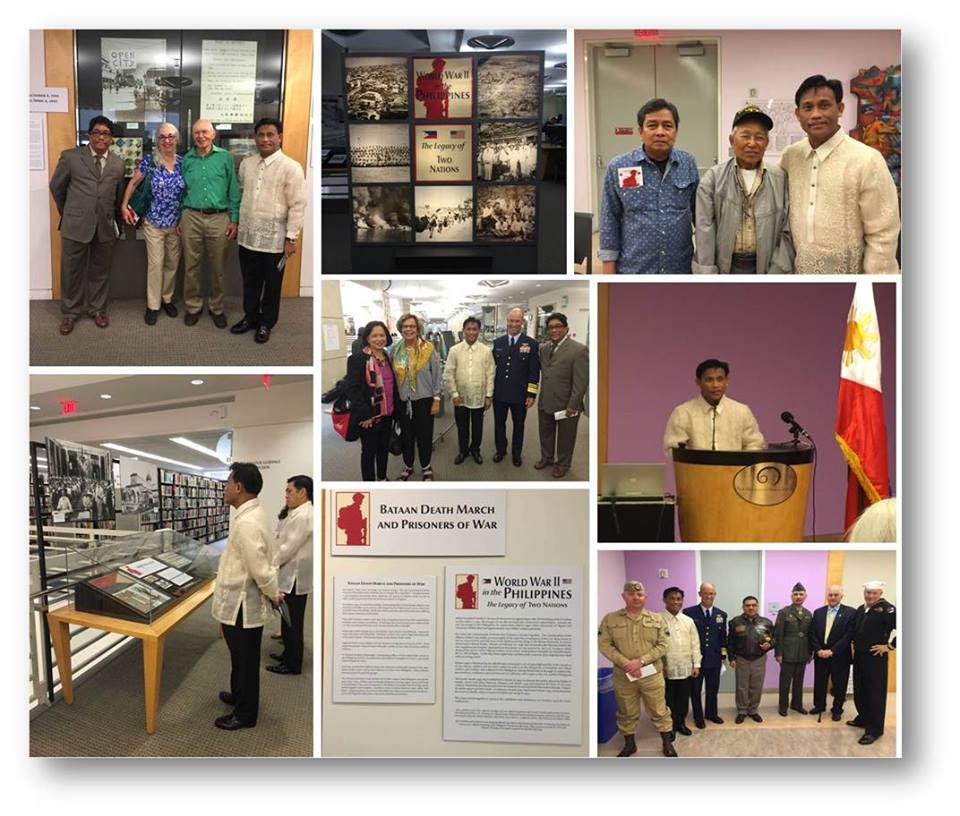
21 September 2015 - “A captive nation had united under bondage to fight in support of the Americans who had once been their conquerors… white and brown brothers who went cold and wet and hungry in tropic mud, who might have given up but did not, who joined forces and grew and survived against incredible opposition, thinking the same thoughts, sharing the same dreams, fighting for the same ideals – equality, fraternity liberty.” At the opening of the exhibit entitled “World War II in the Philippines – A Legacy of Two Nations”, Philippine Consul General to San Francisco Henry S. Bensurto, Jr. quoted General Carlos P. Romulo to commemorate the 70th anniversary of the end of World War II.
Through the efforts of Bataan Legacy Historical Society (BLHS) and Memorare Manila 1945, artifacts and memorabilia from World War II will be on display at the San Francisco Public Library’s Filipino-American Center, found on the third floor, until January 09. The exhibit’s aim is to educate the public about the Philippines’ pivotal role during the War, and to bring greater awareness on the importance of including the Bataan Death March in the social sciences curriculum for Grades 7 to 12.
The Death March symbolized the heroism and suffering of Filipino and American soldiers as they put up a gallant stand against Japanese forces. That stand allowed the Americans time to regroup and eventually turn the tide of war in favor of the Allies, eventually affording the Philippines its freedom. Had it not been for that sacrifice, the world as we know it would have been significantly different.
In his remarks, Consul General Bensurto recounted how San Francisco played a part in the shared history of the Philippines and the U.S. It was in San Francisco that ships were manufactured and sent to the Philippines to maintain its hold in the Pacific. He added that “celebrating this important milestone in San Francisco, the seat of global technology, gives the event a poignancy, as we try to put back a human face and heart into this event,” where roughly 66,000 Filipino soldiers and 12,000 American soldiers were forced to take the deadly 145-kilometer walk from Mariveles, Bataan to San Fernando.
He encouraged those in attendance to let themselves be heard in support of Assembly Bill No. 199, An act to amend Section 51221.3 of the Ducation Code, relating to school curriculum, so that implementation is ensured in middle schools throughout California.
Vice Admiral Charles Ray stressed the importance of eternal vigilance, as history is wont to repeat itself. He mentioned that there is always an opportunity for others to do harm, recalling that the US celebrates the 14th anniversary of 9/11, and that it was important for nations to work in cooperation to achieve the shared value of freedom. He added that the Philippines and the US continue to deepen relations through engagement in exercises such as the establishment of a coast watch system, and the transitioning of two coast guard cutters to the Philippines, which are now patrolling the Philippine seas.
BLHS Founder and Executive Director Cecilia Gaerlan explained how she has been working with the California Department of Education to implement AB 199, and encouraged those present to support the implementation to ensure that each child appreciates the value of freedom, which was bought by the sacrifices of the lives of thousands of Filipino and American soldiers.
The event was attended by Bataan Death March veteran David Tejada, civilian survivors, members of the Coast Guard, the consular corps and the press.
A Bataan Legacy Conference will take place on October 24 at the Library’s Koret Auditorium, featuring speakers from different points of view – World War II Filipino and American veterans, Allied civilian prisoners of war, and civilian survivors. END

